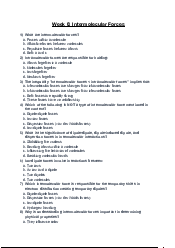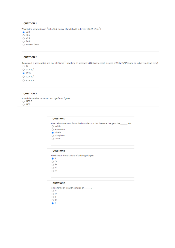



Preview text:
THE INTERNATIONAL UNIVERSITY (IU) – VIETNAM NATIONAL UNIVERSITY – HCMC CHEMISTRY FOR ENGINEERS ASSIGNMENT 1 Date: 3/1/2023
Duration: 1 week, 11:59 PM 10/1/2023
PART I: MULTIPLE CHOICE QUESTIONS (15 points)
1. Which element is INCORRECTLY matched with its symbol?
5. Which of the following is NOT an SI unit a) Cu / copper b) Pb / lead of that measured quantity? c) K / potassium d) B / bismuth
a) Length is expressed in meters
b) Energy is expressed in pokemon
2. The density of Au is 19.3 g/mL. What
c) Time is expressed in seconds
would be the value of a 100 cm3 ingot of gold
d) Mass is expressed in kilograms
if gold is worth $35 per ounce. (Note: There
are 16 ounces in a pound; 1 pound = 0.4536 6. Which of the following numbers has 4 kg) significant figures? a) $ 123 b) $ 2,383 a) 0.04309 b) 0.0430 c) $ 3,500 d) $ 440 c) 0.043090 d) 0.43980
3. Nichrome is an alloy (mixture) commonly 7. Atoms are composed of:
used to make heating elements. It is a) protons, neutrons, electrons
composed of 60% nickel, 24% iron and 16% b) protons, neutrinos, elections
chronium. If you have 2.15 g of nichrome
c) positrons, neutrons, electrons
wire, how much of each element do you
d) positrons, neutrons, negatrons have?
a) 1.6g Ni, 0.31g Fe, 0.24g Cr 8. Choose the correct answer:
b) 1.6g Ni, 0.41g Fe, 0.14g Cr
a) cations have a positive charge, anions
c) 1.3g Ni, 0.52g Fe, 0.34g Cr have a negative charge
d) 1.2g Ni, 0.61g Fe, 0.14g Cr
b) anions have a positive charge, cations have a negative charge
4. In which item below is the result expressed c) the opposite of a cat ion is a dog ion
INCORRECTLY in terms of number of d) uh, what? significant figures? a) 3.14 x 2.584 = 8.11
9. Which two subatomic particles have b) 0.003/0.0015 = 2 approximately the same mass? c) 1.314 + 189.71 = 191.0 a) electrons and nuclei d) all results are corrected. b) neutrons and electrons c) protons and electrons d) protons and neutrons
10. Isotopes are atoms of the same element 12. How many neutrons are in the nucleus of that: this element: 226 Ra 88 ?
a) have different numbers of electrons. a) 138 b) 88
b) have different numbers of protons. c) 226 d) 108
13. Select the element with the electron
c) have different numbers of neutrons. configuration: [Kr] 5s2 4d2. a) Hf b) Y
d). have different atomic numbers c) Zr d) Ti
14. Which combination of protons, neutrons,
and electrons is correct for the 63 C u 29 isotope of Copper?
a) 29 protons, 34 neutrons, and 29 electrons
b) 29 protons, 29 neutrons, and 63 electrons
c) 63 protons, 29 neutrons, and 63 electrons
d) 34 protons, 29 neutrons, and 34 electrons
11. The mass spectrum shown above for an 15. Which of the following elements has the
element shows two mass peaks. Predict the lowest first ionization energy?
atomic mass (g/mole) for this element. a) Be b) Mg a) 25.8 b) 26.0 c) Ca d) S c) 25.5 d) 25.0
PART II: CONSTRUCTED QUESTIONS (55 points)
1. Complete the following table (10 points): NAME COMPOUND How many atoms are
in one “formula unit”? H2SO4 (aqueous) Manganese (VII) oxide Fe(OH)3 Copper (II) chloride hexahydrate HCl (gas) NiCl4 HBr (aqueous) Sodium carbonate decahydrate LiNO2 KCN
2. Draw a sketch of an atom. Label the nucleus, protons, neutrons and electrons and answer following questions (8 pts):
a. Comparing the mass of a neutron to the mass of a proton and a electron, what can we say about this?
b. How large is the nucleus compared to the size of an atom?
c. Atoms of the same element that have different masses are called what?
3. Complete the following table (10 points): Symbol Number of Number of Number of Atomic Mass protons electrons neutron number number 34S-2 18 18 34 1 1 181Ta 8 10 9 92 88 146
4. Part of the universe can be classified into the following categories: compounds, elements,
heterogeneous, homogeneous, matter, mixtures, and pure substances. Organize these in the
boxes of the following hierarchy chart (12 pts).
5. Physical and Chemical properties (5 points):
1. Which of the following describe a chemical change, and which a physical change?
a. Sheep are sheared, and the wool is spun into yarn.
b.Frozen lemonade is reconstituted by adding water to it.
c. Milk turns sour when left out of the refrigerator for many hours
2. Underline the chemical property/properties of chlorine.
At 25°C, chlorine is a green-yellow gas with a density of 3 × 10–3 g/cm3. Chlorine has a melting point of 101°C – and a boiling point of 35° –
C, and the energy required to melt and boil
chlorine is 6.4 and 20.4 kJ/mol, respectively. Chlorine burns in hydrogen to form hydrogen chloride.
6. Give the electron configurations and noble gas abbreviation of the following elements and ions (5 points): a. Ti2+ b. O c. Br- d. Fe e. Cr3+
7. Periodic trends (5 points):
a. Arrange in order of increasing ionization energy: As, F, N
b. Arrange in order of increasing atomic radii: Si, C, F
c. Arrange in order of increasing electron affinity: C, F, Si
d. Arrange in order of increasing electronegativity: S, Si, Ge, Ga
e. Arrange in order of increasing ionization energy: F, O P ,
PART III: IDENTIFICATION AND CORRECTION FALSE STATEMENTS (30 points)
a. The formula of a salt is XCl2. The X-ion in this salt has 28 electrons. The metal X is Cu.
b. Silver has two naturally occurring isotopes 107Ag (106.9051 amu) and 109Ag (108.9048
amu). The average atomic mass of silver is 107.8682 amu. The fraction abundance of 107Ag is 0.5184.
c. Name of compound NH4Cl (g) is ammonia hydrochloric.
d. Almost all of the mass of the atom is concentrated in the nucleus.
e. The protons and neutrons in the nucleus are very tightly packed.
f. An element with the outermost electron configuration ns2np3 would be in group IIIA
g. The electron configuration of selenium (Se) is [Ar] 4s2 3d10 4p4.
h. V has 3 unpaired electrons.
i. Ca has 2 valence electrons.
j. Milk tea with bubbles is the example of homogenous mixture.
k. Maleic acid, which is used to manufacture artificial resins, has the empirical formula
CHO. Its molar mass is 116.1 g/mol. Its molecular formula is C4H4O4.
l. Ca2+ < Sr2+ < Rb+ < Br- 2-
< Se is the trend of increasing radius of these following ions.
m. The cation’s ground-state electron configuration of Co(C 7 2 2H2O3).4H2O is [Ar] 3d 4s
n. A postitive charge particle found in the nucleus is called electron.
o. The reaction of Mg metal with oxygen to form magnesium oxide is an example of a chemical change.
p. An atom is the smallest particle of an element that maintains the chemical identity of that element.
q. Molecules that consist of more than one atom are called polyatomic molecules.
r. Elements with atomic numbers of 9, 17, 35, and 53 are members of the halogen family, meaning "salt formers."
s. In the most fundamental sense, the properties of the elements are periodic functions of their atomic weight.
t. The elements at the far right of the periodic table, except the noble gases, have the
greatest tendency to form anions.
u. Metals have lower ionization energies than nonmetals. Good luck!!!



